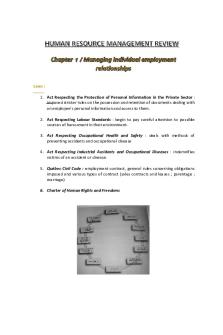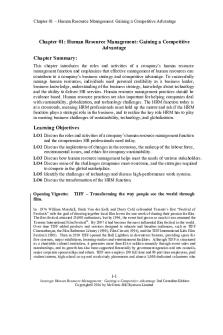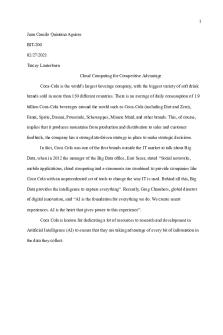Human Resource Management: Managing Employees for Competitive Advantage, Lepak, D. & Gowan, M., 2015, Chicago Business Press PDF

| Title | Human Resource Management: Managing Employees for Competitive Advantage, Lepak, D. & Gowan, M., 2015, Chicago Business Press |
|---|---|
| Author | Kadın Tarihi |
| Course | Strategic management |
| Institution | Washington College |
| Pages | 98 |
| File Size | 2.9 MB |
| File Type | |
| Total Downloads | 33 |
| Total Views | 131 |
Summary
Human Resource Management: Managing Employees for Competitive Advantage, Lepak, D. & Gowan, M., 2015, Chicago Business Press...
Description
HUMAN RESOURCE MANAGEMENT 2e Managing Employees for Competitive Advantage
David Lepak Rutgers University
Mary Gowan James Madison University
HUMAN RESOURCE MANAGEMENT: MANAGING EMPLOYEES FOR COMPETITIVE ADVANTAGE
© 2016 Chicago Business Press
ALL RIGHTS RESERVED. No part of this work covered by the copyright herein may be reproduced, transmitted, stored or used in any form or by any means graphic, electronic, or mechanical, including by not limited to photocopying, recording, scanning, digitizing, taping, web distribution, information networks, or information storage and retrieval systems, except as permitted under Section 107 or 108 of the 1976 United States Copyright Act, without the prior written permission of the publisher.
For product information or assistance, visit www.chicagobusinesspress.com
ISBN-13: 978-0-9833324-3-5
Brief Table of Contents INTRODUCTION 1 Managing Employees for Competitive Advantage 1 PART ONE
HR CHALLENGES 29 2 Organizational Demands and Environmental Influences 31 3 Regulatory Issues 65 PART TWO
WORK DESIGN AND WORKFORCE PLANNING 105 4 Job Design and Job Analysis 107 5 Workforce Planning 151 PART THREE
MANAGING EMPLOYEE COMPETENCIES 189 6 Recruitment 191 7 Selection 233 8 Learning and Development 279 PART FOUR
MANAGING EMPLOYEE ATTITUDES AND BEHAVIORS 325 9 Performance Management 327 10 Compensating Employees 367 11 Incentives and Rewards 407 12 Employee Benefits and Safety Programs 440
iv
Brief Contents
PART FIVE
SPECIAL TOPICS 487 13 Labor Unions and Employee Management 489 14 Creating High-Performance HR Systems 518 Glossary 545 Author Index 555 Company Index 563 Subject Index 567
Table of Contents Preface xvii
1
Managing Employees for Competitive Advantage 1 Managing Employees 2 What’s in a Name? 2 The Costs and Benefits of Managing HR 3
Framework for the Strategic Management ofEmployees 4 Primary HR Activities 6 Work Design and Workforce Planning 7 Job Design 7 Workforce Planning 8
Managing Employee Competencies 8 Recruitment 8 Selection 9 Learning and Development 9
Managing Employee Attitudes and Behaviors 10 Performance Management 10 Compensation and Incentives 11 Employee Benefits, Health, and Wellness 11
HR Activities Alignment 12 HR Challenges 13 Challenge 1: Meeting Organizational Demands 14 Strategy 14 Company Characteristics 15 Organizational Culture 15 Employee Concerns 16
Challenge 2: Environmental Influences 16 Labor Force Trends 16 Technology 17 Globalization 18 Ethics and Social Responsibility 18
Challenge 3: Regulatory Issues 19 The Plan for This Book 20 Ch
t
1 3 HR Ch ll
21
vi
Contents
Chapters 6–8: Managing Employee Competencies 21 Chapters 9–12: Managing Employee Attitudes and Behaviors 21 Chapters 13–14: Special Topics 21
PART ONE
HR Challenges 29
2
Organizational Demands and Environmental Influences 31 The Importance of Context 32 Meeting Organizational Demands 33 Strategy 34 Company Characteristics 36 Organizational Culture 38 Employee Concerns 40
Environmental Influences 43 Labor Force Trends 43 Technology 47 Globalization 48 Ethics and Social Responsibility 52
3
Regulatory Issues 65 Equal Employment Opportunity and Other Workplace Laws 66 Introduction to Equal Employment Opportunity 67 Protected Classifications 68 Bona Fide Occupational Qualification (BFOQ) and Business Necessity 69 Discriminatory Practices 69 Harassment 73 Retaliation 73
Equal Employment Legislation 74 Equal Pay Act of 1963 (EPA) 74 Title VII of the Civil Rights Act of 1964 (CRA 64) 77 Pregnancy Discrimination Act of 1978 (PDA) 84 Civil Rights Act of 1991 (CRA 91) 84 Age Discrimination in Employment Act of 1967 (ADEA) 85 Americans with Disabilities Act of 1990 (ADA) and ADA Amendments Act of 2008 (ADAA) 86 Title II of the Genetic Information Nondiscrimination Act of 2008 (GINA) 88
Use of Social Media and Employment Discrimination 89
Contents
Filing Process for Discrimination Charges 90 Executive Orders and Affirmative Action 91 Executive Order 11246 (EO 11246) 91 Affirmative Action 92
Related Employment Legislation 93 Immigration Reform and Control Act of 1986 (IRCA) 93 Family and Medical Leave Act of 1993, 2008 (FMLA) 94 Vietnam Era Veteran’s Readjustment Assistance Act of 1974 (VEVRAA) 95 Uniformed Services Employment and Reemployment Rights Act of 1994 (USERRA) 95
Fair Employment Practices 95 Employment-at-Will and Wrongful Discharge 96 Regulatory Issues and Competitive Advantage 96 PART TWO
Work Design and Workforce Planning 105
4
Job Design and Job Analysis 107 The Importance of Job Design and Job Analysis 108 Job Design 110 Efficiency Approaches to Job Design 111 Motivational Approaches to Job Design 112 Which Approach to Use? Balancing Efficiency and Motivational Approaches 117
Job Descriptions and Job Specifications 117 Job Analysis 119 Job Information 120 Job Analysis Techniques 122
Job Design in Practice: Organizational Demands 124 Strategy and Job Design 124 Company Characteristics and Job Design 125 Culture and Job Design 126 Employee Concerns and Job Design 127
Job Design in Practice: Environmental Influences 128 Labor Force Trends and Job Design 128 Technology and Job Design 130 Globalization and Job Design 131 Ethics and Job Design 132
Job Design in Practice: Regulatory Issues 134 Importance of Identifying Essential and Nonessential Job Duties 134
vi
viii
Contents
Appendix: Standardized and Customized Approaches to Job Analysis 140 Standardized Approaches to Job Analysis 140 Functional Job Analysis (FJA) 140 Position Analysis Questionnaire (PAQ) 143
Customized Approaches to Job Analysis 144 Critical Incidents Approach 144 Task Inventory Approach 145 Job Element Approach 145
5
Workforce Planning 151 The Importance of Workforce Planning 152 Workforce Planning 153 Forecasting Labor Supply and Labor Demand 154 Internal Factors 155 External Factors 159
Tactics Firms Use to Balance Their Supply and Demand for Labor 161 Labor Shortage Tactics 161 Labor Surplus Tactics 163
Workforce Planning in Practice: OrganizationalDemands 165 Strategy and Workforce Planning 166 Company Characteristics and WorkforcePlanning 167 Corporate Culture and Workforce Planning 168 Employee Concerns and Workforce Planning 168
Environmental Influences and Workforce Planning 170 Labor Force Trends and Workforce Planning 170 Technology and Workforce Planning 172 Globalization and Workforce Planning 173 Ethics and Workforce Planning 175
Regulatory Issues and Workforce Planning 175 Requirements for Mass Layoffs and PlantClosings 176 Determining Who Is an Employee versus an Independent Contractor 176
PART THREE
Managing Employee Competencies 189
6
Recruitment 191 The Purpose of Recruitment 192 Th R
i
P
193
Contents
ix
Internal Recruitment 194 External Recruitment 197
Maximizing Recruitment Effectiveness 204 Preparing Recruitment Advertisements 205 Developing a Recruitment Value Proposition 205 Writing a Recruitment Message 206 Recruiters 207 Realistic Job Previews 208 Recruitment Follow-up 208 Recruitment Effectiveness 208
Recruitment in Practice: Organizational Demands 208 Strategy and Recruitment 209 Company Characteristics and Recruitment 210 Culture and Recruitment 211 Employee Concerns and Recruitment 212
Recruitment in Practice: Environmental Influences 213 The Labor Force and Recruitment 213 Technology and Recruitment 215 Globalization and Recruitment 217 Ethics, Corporate Social Responsibility, andRecruitment 219
Recruitment in Practice: Regulatory Issues 220 Content of a Recruitment Message 220 Recruiters’ Words and Actions 221 Recordkeeping 221
Appendix: Metrics Used to Evaluate an Organization’s Recruiting Effectiveness 227 Yield Ratios 227 Cost-per-Hire 228 Time-to-Fill Rate 228 Manager’s Feedback 229 Benchmarking Best Practices 229
7
Selection 233 Selection Defined 234 How Employee Selection Processes Affect the Performance of Firms 235 Person–Job Fit 236 Standards for an Effective Selection Process 237 Reliability 237 Validity 238 b
d
x
Contents
Selection Methods: Initial Screening 240 Applications and Resumes 241 Behavioral Assessments 242 Screening Interviews 242
Selection Methods: Final Screening 242 Employment Tests 243 Interviews 246 Reference Checks, Background Checks, Credit Reports, and Honesty Tests 248 Assessment Centers 251 Biodata 252 Drug Tests 252 Medical Examinations 253
Choosing Among Selection Methods 253 Compensatory Approach 253 Multiple-Hurdle Approach 254 Multiple-Cutoff Approach 254 Choosing a Scoring Method 254
Selection in Practice: Organizational Demands 256 Strategy and Selection 256 Company Characteristics and Selection 257 Culture and Selection 258 Employee Concerns and Selection 260
Selection in Practice: Environmental Influences 260 Labor Market and Selection 261 Technology and Selection 262 Globalization and Selection 263 Ethics and Employee Selection 265
Selection in Practice: Regulatory Issues 266 Procedures for Using Selection Measures 266 Definition of an Applicant 266
Appendix: Reliability and Validity 272 Reliability 272 Validity 272 Content Validity 272 Criterion-Related Validity 273 Construct Validity 274
8
Learning and Development 279 The Purpose of Learning and Development 280 Employee Orientation 281 Onboarding 281
Contents
Learning, Training, and Development Defined 282 Designing an Effective Training Process 284 Part 1: Needs Assessment 284 Part 2: Design 287 Part 3: Implementation 290 Part 4: Evaluation 299
Career Development 301 Competency Analysis 303 Career Development Activities 303
Learning and Development in Practice: Organizational Demands 303 Strategy and Training 304 Company Characteristics and Training 306 Culture and Training 307 Employee Concerns and Training 308
Learning and Development in Practice: Environmental Influences 309 Labor Market 309 Technology 310 Globalization and Training 311 Ethics and Training 313
Learning and Development in Practice: RegulatoryIssues 315 Accessibility of Training and Employee Development Opportunities 315 Type of Training Needed 316
PART FOUR
Managing Employee Attitudes and Behaviors 325
9
Performance Management 327 Why Performance Management Is So Important 328 Purposes of Performance Management 329 Step 1: Identifying Performance Dimensions 329 Step 2: Developing Performance Measures 331 Valid Measures 331 Performance Measurement Standards 331 Specificity 332
Step 3: Evaluating Employee Performance 332 Individual Comparisons 332 Absolute Approaches: Measuring Traits and Behaviors 334 Results-Based Approaches 337 Sources of Performance Data 338 Weighting Performance Criteria 340 Performance Measurement Errors 341
x
xii
Contents
Step 4: Providing Feedback 342 When to Appraise Employees 343 The Feedback Meeting 343
Step 5: Developing Action Plans to Improve Employee Performance 344 Understanding the Causes of Poor Performance 344 Taking Action 345 Disciplining Employees 346
Performance Management in Practice: Organizational Demands 348 Strategy and Performance Management 348 Company Characteristics and PerformanceManagement 350 Culture and Performance Management 351 Employee Concerns and Performance Management 352
Environmental Influences and PerformanceManagement 354 Labor Force Trends and Performance Management 354 Technology and Performance Management 355 Globalization and Performance Management 356 Ethics and Performance Management 357
Regulatory Issues and Performance Management 358 Efforts to Reduce Discrimination in the Performance Management Process 359 The Importance of Documenting Employee Performance 359
10
Compensating Employees 367 Purpose of Compensation 368 Total Compensation 369 Equity Theory 371 Internal Alignment 372 Job Ranking 373 Job Classification 373 Point Method 374 Factor Comparison 375
External Competitiveness 376 Salary Surveys 376 Job Pricing 377 Company Pay Policy 378 Pay Grades and Pay Ranges 378 Broadbanding 379 Pay for Individual Employees 381
Alternative Compensation Approaches 381 Skill-Based Pay and Knowledge-Based Pay 382 Competency-Based Pay 382 Market Pricing 383
Contents
Administering Compensation 384 Compensation in Practice: Organizational Demands 385 Strategy and Compensation 386 Company Characteristics and Compensation 387 Culture and Compensation 389 Employee Concerns and Compensation 389
Compensation in Practice: Environmental Influences 392 Labor Force and Compensation 392 Technology and Compensation 393 Globalization and Compensation 394 Ethics/Social Responsibility and Compensation 396
Compensation in Practice: Regulatory Issues 397 Davis–Bacon Act 397 Walsh–Healey Public Contracts Act (PCA) 397 Fair Labor Standards Act (FLSA) 397
11
Incentives and Rewards 407 Why Are Incentive Plans Important? 408 How Incentives Work 409 Theories of Motivation 409
Types of Incentive Plans 410 Individual Incentive Plans 410 Group/Organizational Incentives 416 Executive Compensation: Pay and Incentives 419
What Makes an Incentive Plan Effective? 421 Organizational Demands and Incentives 421 Strategy and Incentives 422 Company Characteristics and Incentives 423 Culture and Incentives 424 Employee Concerns and Incentives 425
Environmental Influences and Incentives 427 Labor Force Trends and Incentive Plans 427 Technology and Incentives 428 Globalization and Incentive Plans 429 Ethics, Social Responsibility, and Incentive Plans 430
Regulatory Issues and Incentive Plans 431 Bias and Discrimination 431 Stock Option Backdating 431
xii
xiv
Contents
12
Employee Benefits and Safety Programs 440 Employee Benefits and Safety Programs 441 Benefits and Safety Philosophy 442 Mandatory Benefits 442 Social Security 443 Unemployment Insurance (UI) 444 Workers’ Compensation Insurance 445 Affordable Care Act (ACA) Employer Shared Responsibility Provisions 446
Voluntary Benefits 446 Health and Wellness Programs 447 Life Management Benefits 456 Retirement Benefits 458
Benefits Administration 461 Safety Programs 463 Programs Related to the Occupational Safety and Health Act 463 Workplace Violence Programs 464 Ergonomic Programs 464
Employee Benefits and Safety Programs in Practice: Organizational Demands 465 Strategy, Benefits, and Safety Programs 466 Company Characteristics, Benefits, and SafetyPrograms 467 Company Culture, Benefits, and Safety Programs 468 Employees’ Concerns about Their Firm’s Benefits and Safety Programs 470
Employee Benefits and Safety in Practice: Environmental Influences 471 The Labor Market and Benefits and SafetyPrograms 471 Technology and Benefits and Safety Programs 472 Globalization and Employee Benefits and SafetyPrograms 473 Ethics, Social Responsibility and Benefits and Safety Programs 475
Employee Benefits and Safety Programs in Practice: Regulatory Issues 476 What Happens When Workers Change Jobs 476 Protection of Employee Information 476
PART FIVE
Special Topics 487
13
Labor Unions and Employee Management 489 Labor Relations Overview 490 Brief History of Labor Union Movement in the United States 490
Contents
Government Regulation of Labor Unions 492 Railway Labor Act of 1926 493 Norris-LaGuardia Act of 1932 493 Wagner Act (National Labor Relations Act) 493 Taft-Hartley Act of 1947 495 Landrum-Griffin Act of 1959 498
Types of Unions 498 Local Unions 499 International Unions 499
The Union-Organizing Process 500 Role of Employees, Employers, and Union Organizers 501 Card Checks and Neutrality Agreements 501
Collective Bargaining 502 Good Faith Bargaining 502 Bad Faith Bargaining 502 Negotiating the Agreement 502
The Grievance Process 504 The NLRB’s Role in Unfair Labor Practices 505 Decertification 505 Corporate Campaigns 505 Public-Sector Labor Relations 506 Trends in Labor Relations 506 Changes in Union Activities 506 Social Media and Union Activity 507 New Forms of Employee Organizations 507 Global Trends 509
14
Creating High-Performing HR Systems 518 Principles of High-Performing HR Systems 520 External Fit: Aligning HR Activities with HR Challenges 520 Internal Fit: Aligning HR Activities withOneAnother 521 Aligning HR Systems with Employees’ Contributions 523
Managing the Employment Portfolio 525 Strategic Value 525 Uniqueness 526 Mapping Your Employment Portfolio 527
Evaluating Your HR System: The HR Scorecard 530 Step 1: Identify Your Firm’s Strategic PerformanceDrivers 530 Step 2: Evaluate Your Firm’s External Alignment 531 Step 3: Evaluate Your Firm’s Internal Alignment 532
xv
xvi
Contents
Building Your Own High-Performing Organization 534 Customizing Your HR Scorecard 534 Being Consistent 535 Being Specific 535 Following Up on the Implementation of a Redesign 536
Glossary 545 Author Index 555 Company Index 563 Subject Index 567
Preface The Need for a New Perspective When we finished the first edition of this book, the economy was moving into a recession. Employers were struggling to stay in business. Many employers faced the need to rightsize their workforce while also keeping core employees motivated so the business would remain viable. Now, the economy is on the upswing and employers find that they have new challenges in attracting, maintaining, and retaining the workforce they need for sustaining a competitive advantage. Baby boomers are retiring and taking valuable corporate knowledge with them. Technology is moving at a fast pace. The numbers of high skilled workers entering the workforce are not sufficient to fill all the new and changing technology jobs. Employers are reluctant to invest extensively in training until they are more confident in the continued improvement of the economy. The world continues to shrink and more and more managers find they are overseeing workers in multiple parts of the world. Social media have changed the landscape for both employers and employees. We wrote this book for anyone interested in understanding how to manage employees well in a dynamic and rapidly changing business environment. In the paragraphs that follow, we will describe the approach we use to differentiate our book from the many other human resource textbooks available.
Major Themes of the Book We have heard from consultants and faculty that our framework is right on target with what clients need and what students need to learn, regardless of major. Students told us we had accomplished our goal of providing a readable and engaging textbook. In writing this edition of our book, we continue our focus on providing a strategic framework for managers that is applicable across large and small organizations, regardless of industry or for-profit or not-for-profit status. Our goal is to provide the information and context that any ma...
Similar Free PDFs

Human Resource Management Review
- 40 Pages

human resource management
- 3 Pages

Human Resource Management
- 17 Pages

Human Resource Management
- 49 Pages

Human Resource Management Essay
- 5 Pages

Human Resource Management
- 4 Pages
Popular Institutions
- Tinajero National High School - Annex
- Politeknik Caltex Riau
- Yokohama City University
- SGT University
- University of Al-Qadisiyah
- Divine Word College of Vigan
- Techniek College Rotterdam
- Universidade de Santiago
- Universiti Teknologi MARA Cawangan Johor Kampus Pasir Gudang
- Poltekkes Kemenkes Yogyakarta
- Baguio City National High School
- Colegio san marcos
- preparatoria uno
- Centro de Bachillerato Tecnológico Industrial y de Servicios No. 107
- Dalian Maritime University
- Quang Trung Secondary School
- Colegio Tecnológico en Informática
- Corporación Regional de Educación Superior
- Grupo CEDVA
- Dar Al Uloom University
- Centro de Estudios Preuniversitarios de la Universidad Nacional de Ingeniería
- 上智大学
- Aakash International School, Nuna Majara
- San Felipe Neri Catholic School
- Kang Chiao International School - New Taipei City
- Misamis Occidental National High School
- Institución Educativa Escuela Normal Juan Ladrilleros
- Kolehiyo ng Pantukan
- Batanes State College
- Instituto Continental
- Sekolah Menengah Kejuruan Kesehatan Kaltara (Tarakan)
- Colegio de La Inmaculada Concepcion - Cebu









